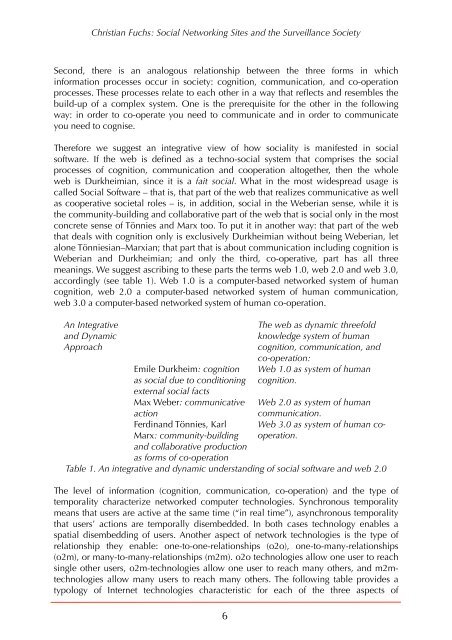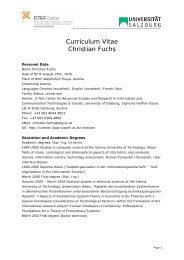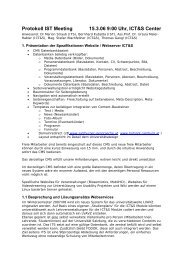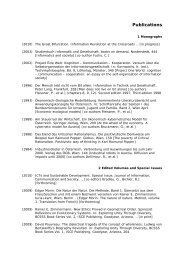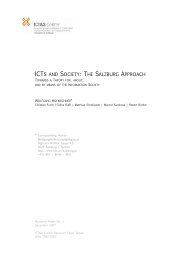CHRISTIAN FUCHS - ICT&S - Universität Salzburg
CHRISTIAN FUCHS - ICT&S - Universität Salzburg
CHRISTIAN FUCHS - ICT&S - Universität Salzburg
You also want an ePaper? Increase the reach of your titles
YUMPU automatically turns print PDFs into web optimized ePapers that Google loves.
Christian Fuchs: Social Networking Sites and the Surveillance SocietySecond, there is an analogous relationship between the three forms in whichinformation processes occur in society: cognition, communication, and co-operationprocesses. These processes relate to each other in a way that reflects and resembles thebuild-up of a complex system. One is the prerequisite for the other in the followingway: in order to co-operate you need to communicate and in order to communicateyou need to cognise.Therefore we suggest an integrative view of how sociality is manifested in socialsoftware. If the web is defined as a techno-social system that comprises the socialprocesses of cognition, communication and cooperation altogether, then the wholeweb is Durkheimian, since it is a fait social. What in the most widespread usage iscalled Social Software – that is, that part of the web that realizes communicative as wellas cooperative societal roles – is, in addition, social in the Weberian sense, while it isthe community-building and collaborative part of the web that is social only in the mostconcrete sense of Tönnies and Marx too. To put it in another way: that part of the webthat deals with cognition only is exclusively Durkheimian without being Weberian, letalone Tönniesian–Marxian; that part that is about communication including cognition isWeberian and Durkheimian; and only the third, co-operative, part has all threemeanings. We suggest ascribing to these parts the terms web 1.0, web 2.0 and web 3.0,accordingly (see table 1). Web 1.0 is a computer-based networked system of humancognition, web 2.0 a computer-based networked system of human communication,web 3.0 a computer-based networked system of human co-operation.An Integrativeand DynamicApproachEmile Durkheim: cognitionas social due to conditioningexternal social factsMax Weber: communicativeactionFerdinand Tönnies, KarlMarx: community-buildingand collaborative productionas forms of co-operation6The web as dynamic threefoldknowledge system of humancognition, communication, andco-operation:Web 1.0 as system of humancognition.Web 2.0 as system of humancommunication.Web 3.0 as system of human cooperation.Table 1. An integrative and dynamic understanding of social software and web 2.0The level of information (cognition, communication, co-operation) and the type oftemporality characterize networked computer technologies. Synchronous temporalitymeans that users are active at the same time (“in real time”), asynchronous temporalitythat users’ actions are temporally disembedded. In both cases technology enables aspatial disembedding of users. Another aspect of network technologies is the type ofrelationship they enable: one-to-one-relationships (o2o), one-to-many-relationships(o2m), or many-to-many-relationships (m2m). o2o technologies allow one user to reachsingle other users, o2m-technologies allow one user to reach many others, and m2mtechnologiesallow many users to reach many others. The following table provides atypology of Internet technologies characteristic for each of the three aspects of


